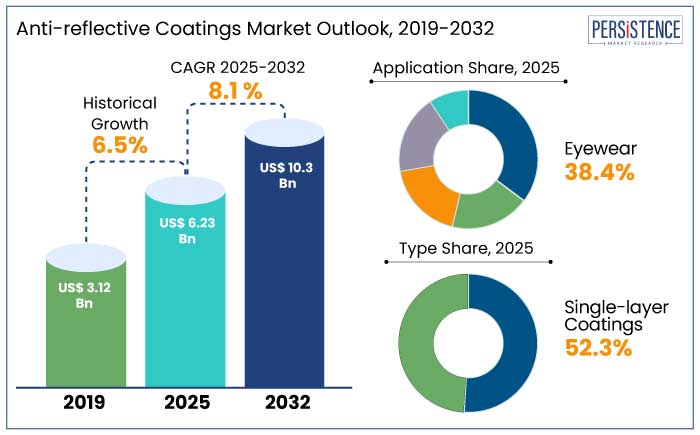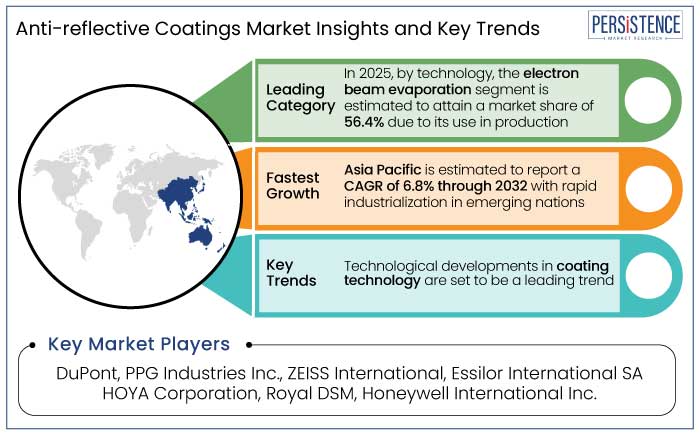Anti-reflective Coatings Market
Industry: Chemicals and Materials
Published Date: January-2025
Format: PPT*, PDF, EXCEL
Delivery Timelines: Contact Sales
Number of Pages: 189
Report ID: PMRREP35112
The global anti-reflective coatings market is estimated to reach a size of US$ 6.23 Bn in 2025. It is predicted to rise at a CAGR of 8.1% through the assessment period to attain a value of US$ 10.3 Bn by 2032.
Anti-reflective coatings are gaining attention in various industries due to their increasing applications in eyeglasses, touch screens, flat panel displays, and smartphone displays. Innovations in manufacturing technology and thin film fabrication are driving growth of the global anti-glare coatings market.
The industry is shifting toward innovative thin film fabrication technologies, with manufacturers investing in research and development for ultrathin anti-reflective coatings.

Key Highlights of the Market
|
Market Attributes |
Key Insights |
|
Market Size (2025E) |
US$ 6.23 Bn |
|
Projected Market Value (2032F) |
US$ 10.3 Bn |
|
Global Market Growth Rate (CAGR 2025 to 2032) |
8.1% |
|
Historical Market Growth Rate (CAGR 2019 to 2023) |
6.5% |
North America's demand for reflector coatings is driven by specialized innovations in the region, with a projected 28.5% market share in the sector in 2025. Reflector coatings are mainly in demand in the U.S., Mexico, and Canada because of their sophisticated technology and strong demand from industries including electronics, semiconductors, and solar energy. For instance,
Given its advantageous location as a manufacturing hub, Mexico is predicted to have development potential in North America, with a CAGR of 5.6% predicted between 2025 and 2032. Consumer electronics demand at home and North America's expanding solar energy industry support the market's steady expansion.
Asia Pacific, led by China and India, is set to dominate the global anti-reflective coatings market, accounting for 43.4% of the share in 2025 and achieving a CAGR of 6.8% from 2025 to 2032. Growth of the industry in Asia Pacific is attributed to increasing use of electronic devices, solar energy projects, and the demand for anti-reflective eyewear.
Demand for anti-reflective layering is projected to rise steadily due to Asia Pacific's fast industrialization and emphasis on sustainable energy sources.
In 2025, single-layer coatings are anticipated to dominate the global coatings industry, accounting for a share of 52.3%. These coatings are popular due to their cost-effectiveness, ease of application, and environmental protection in the automotive and construction sectors, which reduce production time while maintaining durability. For example,
The preference for single-layer coatings is anticipated to persist due to ongoing innovation and surging usage in emerging regions.
Electron beam evaporation is predicted to dominate the anti-reflective coatings industry, accounting for 56.4% of the market share in 2025. This is due to its precision, purity, and efficiency. The technique, widely used in industries like electronics, optics, and solar energy, is preferred due to its rapid deposition rates, material versatility, and environmental benefits. For example,
Demand for anti-reflective coatings is rising in the automobile sector due to several causes, including the use of solar panels, the need for eyeglasses, and emerging technologies. The automotive industry's shift toward unique driver displays has led to a 65% increase in anti-reflective coating applications. For instance,
In the first quarter of 2024, military contracts for specialist coatings increased by 85% due to the aerospace industry's breakthroughs in anti-reflective covering requirements for cockpit displays and sensors.

The global market recorded a CAGR of 6.5% in the historical period from 2019 to 2023. The global pandemic has disrupted the anti-reflective coatings market, but a few players are overcoming obstacles, indicating substantial development in the next ten years.
Manufacturers are extending their product lines in response to the market's booming demand from a variety of industries, including electronics, automotive, and healthcare. Demand in the automotive and construction industries has declined owing to supply chain disruptions, but rising need for anti-reflective coatings is predicted to boost the industry. Demand for products featuring anti-reflective covers is estimated to record a considerable CAGR of 8.1% during the forecast period between 2025 and 2032.
Demand to Skyrocket from Glasses and Lenses Manufacturers
Rising demand for high-transmitting lenses and spectacles, as well as development of the eyewear industry due to visual impairments and an aging population that affects over 2.2 billion people worldwide, are likely to drive demand for eyeglasses with anti-reflective layers. According to a few studies, eyewear applications are projected to account for 38.4% of the market for anti-reflection coatings in 2025. For example,
Installation of solar panels with high anti-reflective coatings improves photovoltaic cell performance used in the industry. Introduced in November 2023, Saint-Gobain's ARco Solar coatings have the potential to boost solar panel production by as much as 10%, emphasizing the need for anti-reflective coatings in unique optics and sustainable energy.
Ongoing Innovations in Coating Technology to Boost Demand
Applications like optical, solar energy, and automotive are adopting coating technologies as these improve performance and durability across a range of sectors. Innovations that improve scratch resistance, thermal stability, and optical clarity, all of which prolong product lifespans, showed a 9% increase in the worldwide coatings technology market in 2023. For example,
Novel coatings match customer expectations for high-performance materials while contributing to sustainability by minimizing the need for frequent replacements and setting new efficiency and reliability norms.
High Production Cost May Affect Adoption in Future
For small and medium-sized businesses, especially those that make eyeglasses, the high cost of anti-reflective coatings is a leading obstacle. Because of the high cost of raw ingredients, the complexity of production, and the expenses associated with the application, these companies could be hesitant to invest in such coatings.
Manufacturers can then resort to less expensive substitutes, which frequently don't perform as well as premium coatings. Reliance on inferior goods may hinder industry innovation and client confidence, which might hamper growth of the global anti-reflective coatings market.
Aerospace and Defense Applications to Require Specialized Anti-reflective Solutions
Specialized anti-reflective coatings, which increase visibility and lessen glare, are gaining popularity in the aerospace and military industries. New standards that prioritized performance and endurance in harsh environments were established in March 2024, which makes the coatings ideal for the defense sector.
Military contracts for coating increased by 85% in Q1 2024, driven by rising investments in unique technologies and surging defense budgets, indicating a significant growth in the aerospace coatings market. For example,
Electronics and Display Manufacturers to Create Novel Opportunities
Increased demand from electronics and display makers for better visual clarity, less glare, and superior user experience in smartphones, tablets, monitors, and TVs is driving demand for anti-reflective coatings. Shipments of smartphones worldwide peaked at 1.4 billion units in 2023, according to recent statistics, indicating strong development in the electronics sector. For instance,
As customer demand for sophisticated electronics rises, anti-reflective coatings are essential for wearable technology as these assure readability in a variety of lighting conditions and spur innovation in the electronics sector.
Businesses seek to increase their footprint through strategic moves like mergers and acquisitions. Hefty investments in research and development to innovate and satisfy customer demands are also anticipated in the next ten years in the global anti-reflective coatings market.
Collaboration with electronics and packaging sectors is set to boost global sales of anti-glare covers, allowing companies to extend their reach and capitalize on new opportunities. Start-ups in the anti-reflective coatings sector are poised to impact on the industry due to innovations in technology and product development. These companies are well-positioned to capture market share and contribute to industry growth, fostering innovation and enhancing global customer choices through their new solutions.
Recent Industry Developments
|
Attributes |
Details |
|
Forecast Period |
2025 to 2032 |
|
Historical Data Available for |
2019 to 2023 |
|
Market Analysis |
US$ Billion for Value |
|
Key Regions Covered |
|
|
Key Market Segments Covered |
|
|
Key Companies Profiled in the Report |
|
|
Report Coverage |
|
|
Customization and Pricing |
Available upon request |
By Type
By Technology
By Application
By Region
To know more about delivery timeline for this report Contact Sales

The market size is set to reach US$ 10.3 Bn by 2032.
Experts suggest that an anti-reflective coating should last between one and two years, depending on the user and treatment methods used.
In 2025, North America is set to attain a market share of 28.5%.
In 2025, the market is estimated to be valued at US$ 6.23 Bn.
DuPont, PPG Industries Inc., ZEISS International, Essilor International SA, and HOYA Corporation are a few key players.